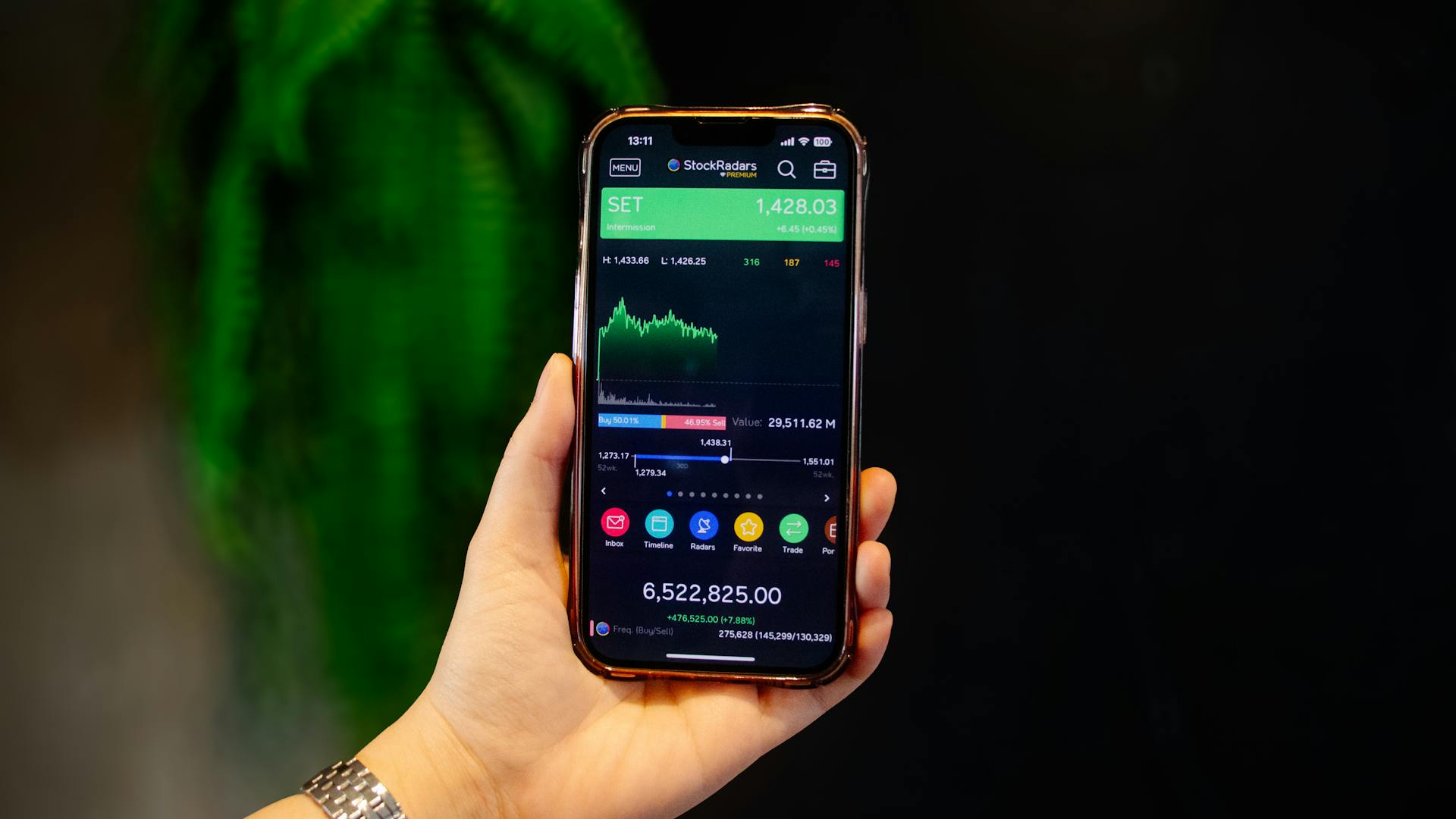
Day trading and long term investing are two vastly different approaches to the stock market. Day trading involves buying and selling securities within a single trading day, with the goal of profiting from small price movements.
The main difference between day trading and long term investing is the time frame. Long term investing, on the other hand, involves holding onto securities for months or even years.
Day traders typically make multiple trades in a single day, with some making up to 10-20 trades in a single day. Long term investors, by contrast, tend to hold onto their securities for much longer periods of time.
Long term investors often focus on the overall performance of the market and the potential for long term growth, rather than trying to time the market or make quick profits.
Curious to learn more? Check out: Do Angel Investors Get Equity
What is Day Trading?
Day trading is a style of investing where you buy and sell securities within a short period, usually on the same trading day. It's a high-risk, high-reward approach that requires a lot of research and strategy.
Additional reading: Vanguard High Dividend Yield Index Etf
To be a successful day trader, you need to focus on stocks with good volume and some volatility, but not too much. This means you're looking for stocks that trade frequently and have a decent price movement throughout the day. Currency markets are also highly liquid, making them a popular choice for day traders.
Day traders often rely on technical analysis, studying the movements of stocks on a chart to make informed decisions. Some day traders stick to a few familiar stocks, while others trade dozens of different securities in a day. The goal is to make a profit from small mispricings in the market, like when a stock's price drops temporarily due to external factors.
Day trading is different from investing, where you hold onto assets for the long-term. Traders focus on short-term gains, while investors study a company's potential for long-term growth or value. Day traders might be in a position for just minutes, while swing traders invest for days or weeks.
Here are some key characteristics of day trading:
- Good volume: Traders look for stocks that trade frequently and have a decent price movement throughout the day.
- Some volatility: A stock's price should change frequently, but not too much, to provide opportunities for profit.
- Familiarity: Traders want to understand how the security trades and what triggers moves.
- Newsworthiness: Media coverage can create volatility and liquidity, making it easier to buy and sell stocks.
Remember, day trading is not the same as investing in penny stocks, which are stocks that trade for less than $5. While some day traders focus on penny stocks, day trading is possible for all stocks, including blue chip stocks.
Day Trading Strategies
Day trading strategies can be a thrilling way to invest in the stock market, but it's essential to find a strategy that works for you. You may want to specialize in a specific strategy or mix and match from among some of the following typical strategies.
Range trading or swing trading involves finding a stock that tends to bounce around between a low and a high price, and buying when it nears the low and selling when it nears the high. This strategy requires a trader to closely watch a stock's order flow to anticipate when to buy and sell.
Spread trading is a high-speed technique that tries to profit on temporary changes in sentiment, exploiting the difference in the bid-ask price for a stock. For example, if a buyer's bid price drops suddenly, the day trader might step in to buy and then try to quickly resell at the stock's ask price or higher.
Worth a look: Ice Bofa High Yield Index
Fading involves short-selling a stock that has gone up too quickly when buying interest starts to wane. The trader might close the short position when the stock falls or when buying interest picks up. Momentum, or trend following, tries to ride the wave of a stock that's moving, either up or down.
Curious to learn more? Check out: Gold to Silver Ratio When to Buy
How to Start Day Trading
To start day trading, you'll need to open a brokerage account in about 15 minutes. This will give you access to the markets and allow you to begin trading.
You'll also want to establish a trading strategy before you start, which will help you avoid making emotional decisions when things get tough. This means having an exit plan for each of your investment holdings.
It's essential to be patient when day trading, looking for trading opportunities that meet your strategic criteria. If the situation doesn't meet it, don't trade - you don't have to trade if nothing looks attractive.
Worth a look: Higher Expected Returns on Investment Will
To stay informed, continually watch what's happening in the markets, as big news can change the whole tenor of the market, moving your positions without any company-specific news.
Here are some popular brokers for day trading:
If you're not ready to trade with real money, consider paper trading with a stock market simulator first. This will allow you to practice advanced trading strategies, like day trading, with fake cash before risking real money.
For another approach, see: Real Estate Investment Returns
The Best Times to Trade
The best times to trade are crucial for day traders, and the data is clear. The stock market offers the most liquidity and volatility in the hours after it opens, from 9:30 a.m. to about noon ET.
Day traders can expect to see a concentration of trades during this time, as well as in the last hour of trading before the close at 4 p.m. ET.
A third of all S&P 500 stock trades happen in the final 10 minutes of the trading day, making it a prime time to capitalize on opportunities.
Additional reading: Thinkorswim Day Trades Left
Day Trading Risks
Day trading risks are a major concern for anyone considering this type of investing. 95% of day traders lose money, indicating high risks in short-term trading strategies.
The frequency of trading is a significant factor in day trading risks. Day traders often make multiple trades in a single day, which can lead to a higher risk of losses. This is because each trade carries a risk of loss, and the more trades you make, the higher the risk.
Position sizing is also crucial in day trading. If the trade goes wrong, how much will you lose? The answer depends on the size of your position, and it's essential to consider this before making a trade. A good rule of thumb is to limit your losses to a certain percentage of your portfolio.
Volatility is another significant risk in day trading. Stocks don't always go up, and even if they do, there's no guarantee they'll continue to do so. This means that day traders must be prepared for sudden changes in market conditions.
Here's an interesting read: Turtle Traders
A margin account can also increase the risk of day trading. Day traders can use 4X leverage intraday, which enables bigger profits using more shares, but it also enables larger losses in small price moves. This can lead to a rapid depletion of capital.
Here are some key factors to consider when evaluating the risks of day trading:
- Position sizing: How much will you lose if the trade goes wrong?
- Percentage of your portfolio: How much will your overall portfolio suffer if a position goes bad?
- Losses: What level of losses are you willing to endure before you sell?
- Selling: At what point do you sell after making a profitable trade?
It's essential to have a plan for when to close a position, whether it's purely mechanical or based on how the stock or market is trading that day. Proper risk management prevents small losses from turning into large ones and preserves capital for future trades.
Worth a look: Vanguard Index Funds S
Day Trading vs Long-term Investing
Day trading involves holding onto assets for a short-term, often just minutes, whereas long-term investing focuses on a company's potential for long-term growth or value.
Traders often focus on technical factors, like a stock's direction, whereas investors study a company's long-term prospects. Scalp traders might be in a position for just minutes, while day traders are focused on the trading day.
Investors who hold onto assets for the long-term tend to avoid the emotional swings that afflict most day traders, and the odds of turning a profit over a long time horizon are overwhelmingly in their favor.
On a similar theme: Accounting for Long-term Liabilities
Wisely
Wisely, it's essential to understand the key differences between day trading and long-term investing. Day traders focus on short-term gains, often analyzing technical factors like stock charts, and may trade dozens of securities in a single day.
To be a successful day trader, you'll want to focus on stocks with good volume, some volatility, familiarity, and newsworthiness. This means understanding how the security trades, what triggers price movements, and being aware of media coverage that can create liquidity and volatility.
Day traders often rely on technical analysis, whereas investors study a company's long-term prospects and potential for growth or value. Investors typically hold onto assets for the long haul, whereas day traders are focused on making quick profits.
Here are some key differences between day trading and long-term investing:
Investors should create an investment plan, consider index funds, and know their strategy to achieve long-term wealth. This includes understanding their goals, risk tolerance, and being patient and disciplined to ride out market fluctuations.
Day Trading vs Long-term Investing
Most day traders, even those at institutions, tend to be extremely well-versed in how markets move in the short term. Expert poker players study and practice relentlessly to excel at the game, and it's similar with successful day traders.
The minute-to-minute stock price movements on any particular day are little more than random. This randomness makes it difficult to predict market trends.
The probability that you know something professional investors do not, without it being illegal insider information, is extremely unlikely. You're trading against sophisticated institutional investors and high-frequency trading machines.
Most of the time, day trading is not profitable. The inherent nature of the capital markets makes it a losing proposition.
Additional reading: Emerging Markets Equity Fund
vs.
Day trading focuses on short-term gains, with some traders holding onto positions for just minutes or days.
Traders often focus on a stock's technical factors, like its price movement, rather than a company's long-term prospects.
Day traders might take advantage of small mispricings in the market, like temporary price drops due to political uncertainty.
Recommended read: Share Price Tips Industries
Investors, on the other hand, study a company's potential for long-term growth or value and hold onto assets for the long-term.
Looking to trade? Day trading platforms can help you get started, but keep in mind that the odds of turning a profit are against you.
Long-term, buy-and-hold investors tend to avoid the emotional swings that come with day trading, even when their holdings gain value.
Investing in low-cost ETFs over the long-term can give you a much higher chance of turning a profit compared to day trading.
If this caught your attention, see: Long-Term Capital Management
Is Day Trading Right For You?
Day trading is hardly worthwhile for most investors, with its high risks and low returns. Historically, the S&P 500 has an annualized total return of about 10%, not accounting for inflation.
Investors who buy and hold low-cost index funds can see higher returns over a long period. This approach is a more reliable way to grow your wealth.
It's paramount to set aside a certain amount of money you can afford to lose if you're going to day trade. Don't trade more than that amount or use the mortgage or rent money.
Day trading requires a significant amount of time and effort, which can be a challenge for many people.
A fresh viewpoint: Low Cost Index Funds Voo
Stock Types
Stocks are simply a vehicle for trading, with traders focusing on volume and volatility to create tradeable price action.
Traders view stocks as three or four letter opportunities, whereas investors see them as companies with strong fundamentals worthy of long-term holding.
Investors may buy into companies with strong financials, but traders are more concerned with the underlying market dynamics.
Investors may also buy stocks they feel are undervalued or a turnaround situation, where horrible financial metrics are being turned around.
Ultimately, the approach to stocks depends on whether you're a trader or an investor, with each group having different goals and strategies.
Readers also liked: How Do Angel Investors Make Money
Taxation and Planning
Day trading can be costly due to the short-term capital gains tax rate, which is the same as your ordinary income tax rate.
The tax rate for short-term capital gains is significantly higher than the rate for long-term capital gains, which are taxed only after a year or longer.
Consider reading: Wealthfront Tax Loss Harvesting
You'll owe state and federal income tax on your gains if you buy and sell a stock within the same trading day, making day trading a less tax-efficient strategy.
Reducing portfolio turnover through long-term investing can help lower your tax bill, and working with a financial advisor can help offset the tax impact of selling a fund.
Consider reading: Tax Deductions for Day Traders
Tax Planning Opportunities
Tax planning opportunities can be a game-changer for investors.
Reducing portfolio turnover is key to lowering your tax bill, and long-term investing can help you achieve this goal.
By holding onto your investments for at least a year, you can avoid the higher tax rates applied to short-term capital gains.
This can result in significant tax savings, especially if you're working with a financial advisor who can help you offset the tax impact.
A financial advisor can work to pick specific lots or use tax-loss harvesting to minimize the tax burden when you do need to sell a fund.
This strategy can be particularly effective for investors who have a large portfolio or who are looking to minimize their tax liability.
For your interest: Why Are Etfs More Tax Efficient than Mutual Funds
Wash-Sales Rule
The wash-sale rule is a tax regulation that can catch investors off guard.
The rule applies when a stock is sold at a loss and then repurchased within 30 days.
This means that the initial loss can’t be claimed for taxes.
Investors need to wait at least 31 days before buying back into the same stock.
Frequently Asked Questions
Can you realistically make money day trading?
Making a living from day trading is extremely challenging, with a success rate of around 4% for those with adequate capital and a well-honed strategy. However, with dedication and the right approach, it's possible to achieve success in this high-risk, high-reward field.
Sources
- https://www.nerdwallet.com/article/investing/how-to-day-trade-safely
- https://www.fool.com/investing/how-to-invest/stocks/day-trading/
- https://www.forbes.com/sites/kristinmckenna/2021/04/26/trading-vs-investing-which-is-better-for-long-term-goals/
- https://centerpointsecurities.com/day-trading-vs-investing/
- https://www.nerdwallet.com/article/investing/stock-trading-vs-investing
Featured Images: pexels.com


